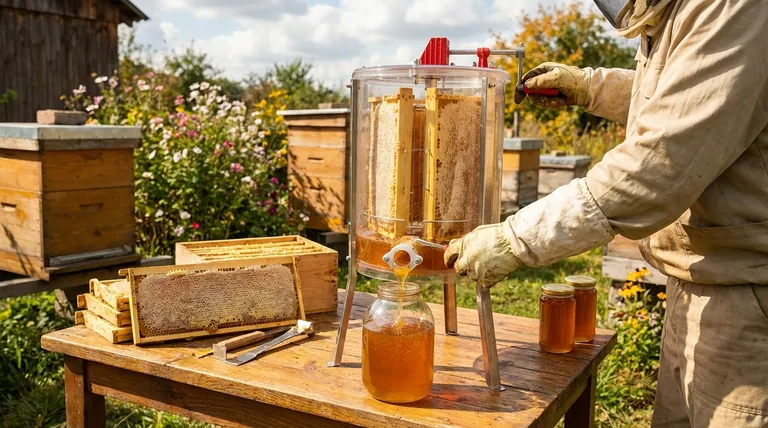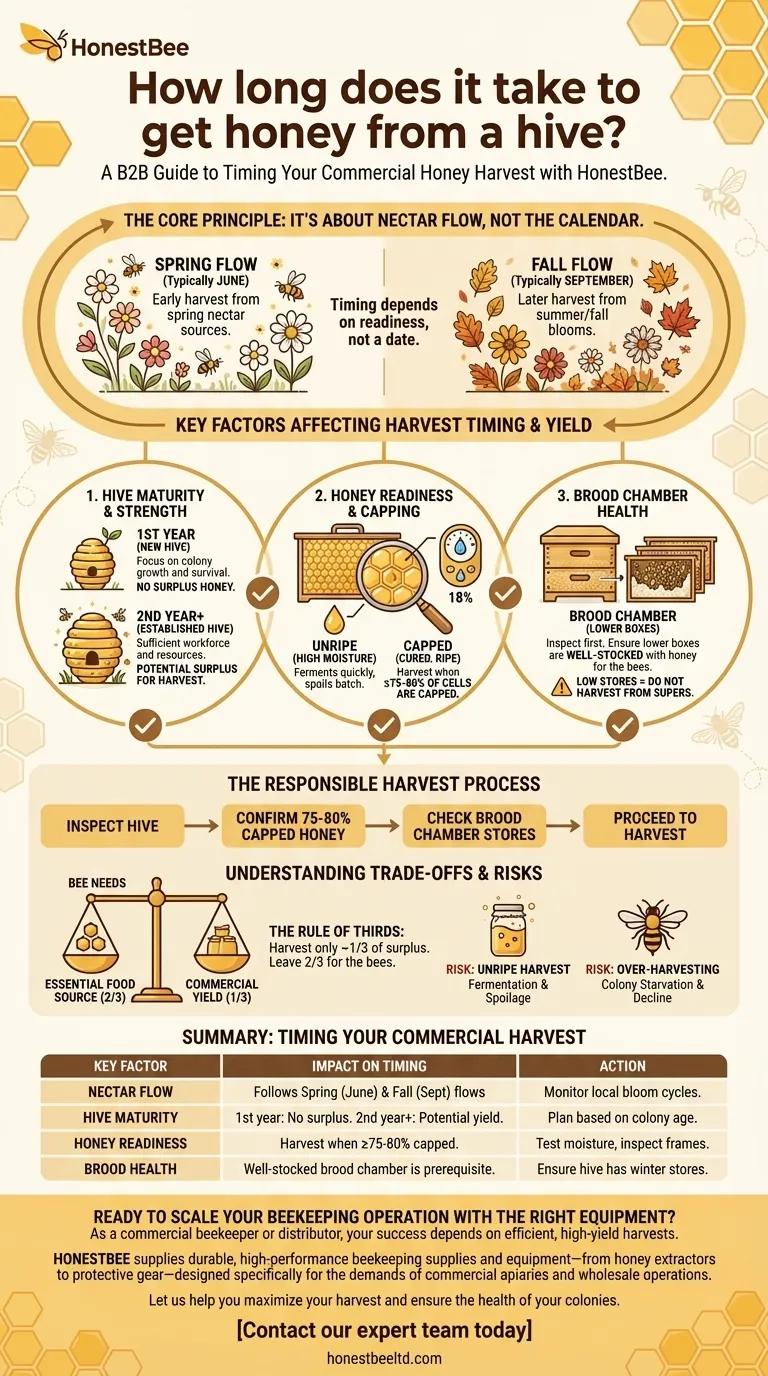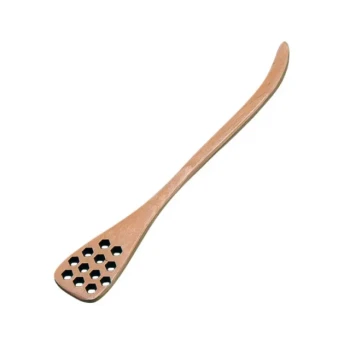In short, you can typically harvest honey in the summer or early fall, often in June from the spring nectar flow or in September from the fall flow. However, the exact timing is not determined by a calendar date, but by the readiness of the honey and the health of the bee colony.
The question isn't simply "when" you can take honey, but "under what conditions" it is ready and responsible to do so. The time it takes is dictated by the bees' progress in filling, curing, and capping the honeycomb, which can vary significantly from one hive to another.

The Core Principle: It's About Nectar Flow, Not the Calendar
A common mistake is to plan a harvest around a specific date. A successful harvest is timed to the rhythms of your bees and their environment.
Understanding Nectar "Flows"
The term "nectar flow" refers to a period when an abundance of local plants are producing nectar for bees to collect. Beekeepers often talk about a "spring flow" and a "summer/fall flow."
Your first potential harvest comes after the major spring flow, often around June. A second, larger harvest is common in the early fall (September) after the bees have collected from summer and fall-blooming plants.
Hive Maturity and Strength
A brand-new hive will likely produce no surplus honey in its first year. The colony's primary focus is on building its population, drawing out comb, and storing enough resources just to survive its first winter.
An established, thriving colony in its second year or beyond has the workforce and resources needed to produce a surplus for you to harvest.
The Role of Location and Weather
The timing mentioned (June, September) are general guidelines. Your specific climate, region, and even the year's weather patterns will shift these dates. A late frost, a drought, or a rainy summer can all impact when and how much honey is produced.
Recognizing When the Honey is Ready
Before you can harvest, you must inspect the hive to confirm the bees have finished their work. Harvesting too early can ruin the honey and harm the colony.
The Critical Sign: Capped Honeycomb
When bees have filled a cell with nectar and fanned their wings to reduce its moisture content to about 18%, they seal it with a fresh wax cap. This is "capped honey," and it is cured, or "ripe."
You should only harvest a frame when at least 75-80% of the cells are capped. This ensures the honey has the correct moisture level and will not ferment in storage.
Inspecting the Brood Chamber First
Before taking any honey from the upper boxes (the "honey supers"), you must inspect the lower boxes (the "brood chambers"). The brood chamber is the heart of the colony, where the queen lays eggs and the bees store their immediate food supply.
If the brood boxes are light on honey, you must not harvest from the supers. Taking their surplus when their primary stores are low can lead to the colony starving.
Understanding the Trade-offs and Responsibilities
Harvesting honey is a partnership. Your goal is to take only what the bees can truly spare, ensuring the long-term health and survival of the colony.
How Much to Take? The Rule of Thirds
A widely accepted best practice is to harvest only about one-third of the surplus honey. The remaining two-thirds should be left for the bees as their essential food source, especially to survive the winter.
The Risk of an Unripe Harvest
Harvesting honey that isn't sufficiently capped is a common beginner's mistake. This "unripe" honey has a high moisture content and will quickly ferment, spoiling the entire batch.
The Danger of Over-Harvesting
Taking too much honey is the most serious error a beekeeper can make. It forces the colony into a desperate situation and can easily lead to starvation, especially if the subsequent season has a poor nectar flow. Always err on the side of leaving too much honey for your bees.
Making the Right Choice for Your Hive
Your approach to harvesting depends entirely on the state of your colony.
- If you have a new hive in its first year: Your primary focus is colony health, not honey. Plan on not taking any honey at all.
- If you have an established hive: You can plan for a harvest after the main nectar flows, but only after confirming the frames are fully capped and the brood chambers are well-stocked.
- If you are using a top bar hive: The principles of timing are the same, but the method is simpler. You will cut the comb from the bars and use a "crush and strain" technique instead of a centrifugal extractor.
Ultimately, your role is to be a steward of the hive, and a thoughtful harvest is your reward for ensuring its prosperity.
Summary Table:
| Key Factor | Impact on Harvest Timing |
|---|---|
| Nectar Flow | Main harvests typically follow spring (June) and fall (September) flows. |
| Hive Maturity | New hives (1st year) produce no surplus; established hives (2nd year+) can yield honey. |
| Honey Readiness | Harvest only when 75-80% of honeycomb cells are capped by the bees. |
| Brood Chamber Health | Ensure lower brood boxes are well-stocked with honey before harvesting from supers. |
Ready to scale your beekeeping operation with the right equipment?
As a commercial beekeeper or distributor, your success depends on efficient, high-yield harvests. HONESTBEE supplies durable, high-performance beekeeping supplies and equipment—from honey extractors to protective gear—designed specifically for the demands of commercial apiaries and wholesale operations.
Let us help you maximize your harvest and ensure the health of your colonies. Contact our expert team today to discuss your wholesale needs and discover how our equipment can support your business growth.
Visual Guide

Related Products
- HONESTBEE 3-Frame Manual Acrylic Honey Extractor
- Plastic Hand Crank 2 Frame Honey Extractor Low Price
- HONESTBEE 72 Frame Industrial Electric Honey Extractor for Beekeeping
- HONESTBEE 8 Frame Electric and Manual Three Use Honey Extractor
- 2 Frame Stainless Steel Manual Honey Spinner Extractor for Beekeeping
People Also Ask
- How often do beekeepers collect honey? Maximize Your Hive's Sustainable Yield
- What is the most common method for cleaning a honey extractor? Protect Your Honey & Equipment
- What machines are needed in beekeeping besides basic tools? Scale Your Honey Harvest Efficiently
- How do you collect honey at home? A Beginner's Guide to Harvesting from Your Hive
- What size honey extractor do I need? Match Frame Capacity to Your Hives for Maximum Efficiency



















